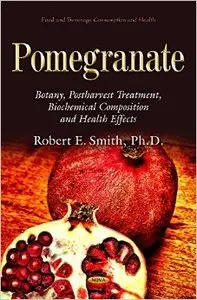Robert E. Smith, "Pomegranate: Botany, Postharvest Treatment, Biochemical Composition and Health Effects"
2014 | ISBN-10: 1633216489 | 265 pages | PDF | 3 MB
2014 | ISBN-10: 1633216489 | 265 pages | PDF | 3 MB
PREFACE
Pomegranate fruits along with their seeds, peels, flowers and juice have been consumed for thousands of years as foods and medicines. They contain dietary fiber, antioxidants, healthy unsaturated fats, minerals and other nutrients. They are grown around the world, but prefer a relatively warm, dry Mediterranean climate. The taste and aroma of the fruits and other parts of pomegranates depends on the age and maturity of the fruit, how it is processed after being harvested and how it is stored. They may be useful in helping to prevent and/or treat illnesses and conditions such as smoldering inflammation, obesity (metabolic syndrome), hyperglycemia, hypertension (high blood pressure), diabetes, stroke, heart diseases, several types of cancer and infectious diseases. However, unlike prescription drugs that have been through rigorously controlled clinical studies, pomegranates and products made from them are not prescribed or covered by health insurance. So, it is important to refrain from making false claims about the health effects of pomegranates. This is better understood if one has a sufficient background.
So, the book starts with an introductory chapter that provides some background about pomegranates and also describes the difference between proving something and getting a product approved by the US FDA or other countries‘ regulatory agencies. That is, a prescription drug must be manufactured in accordance with current good laboratory manufacturing practices (cGMP), tested for possible toxicity using good laboratory practices
(GLP) and evaluated further using good clinical laboratory practices (GCLP). A very small percentage of all investigational new drugs (INDs) successfully navigate through the process and become approved drugs. Throughout the process, all procedures need to be well documented in writing. This is an essential part of western medicine. The spoken word is almost useless, in contrast to pomegranates and other foods which are selected by traditional
methods. People often choose the foods juices and dietary supplements that they consume based on what they see and are told by parents, older siblings and friends. Verbal anecdotes, undocumented experiences and commercial advertisements are far more important influences on what people decide what to eat and drink than anything that is written in the scientific literature. So, all that one can say is that pomegranates and products made from them may help prevent and treat (but not cure) several diseases. However, this is best done as part of physically active, low-stress behaviors and a proper well-balanced diet. So, the importance of these factors in modern medicine is discussed in the introduction.
This is followed by chapters on the history and botany of pomegranates, production, postharvest treatment, biochemical composition and potential health effects. Since this includes some biology and chemistry, there is also an Appendix that provides a chemistry background for biologists, a biology background for chemists and a medicinal biochemistry background for both. That is, there is a relatively thorough discussion of phenolic
antioxidants, DNA, RNA, proteins, lipids and carbohydrates. The chemicals and nomenclature mentioned in the chapter on biochemical composition are also clarified.



